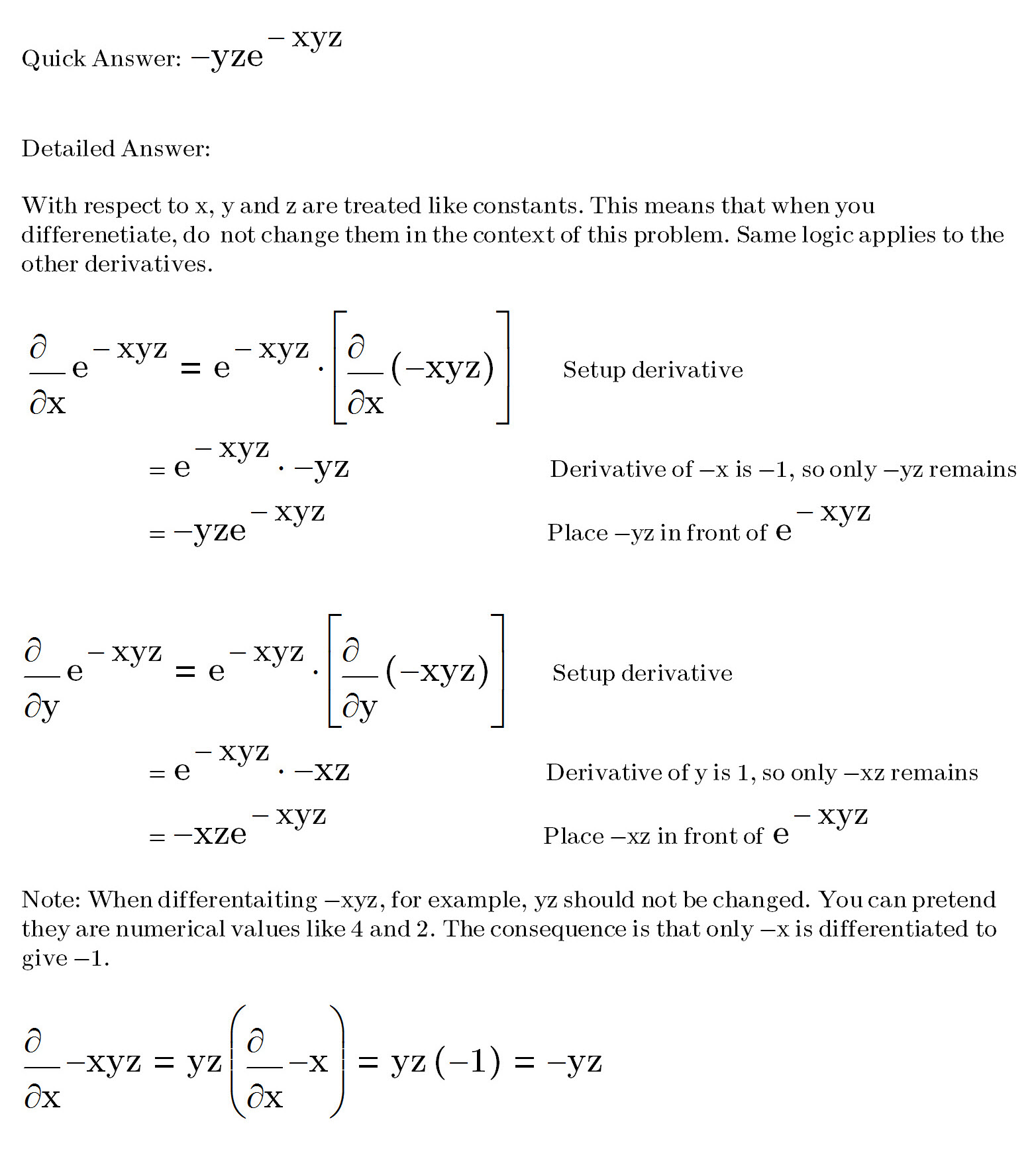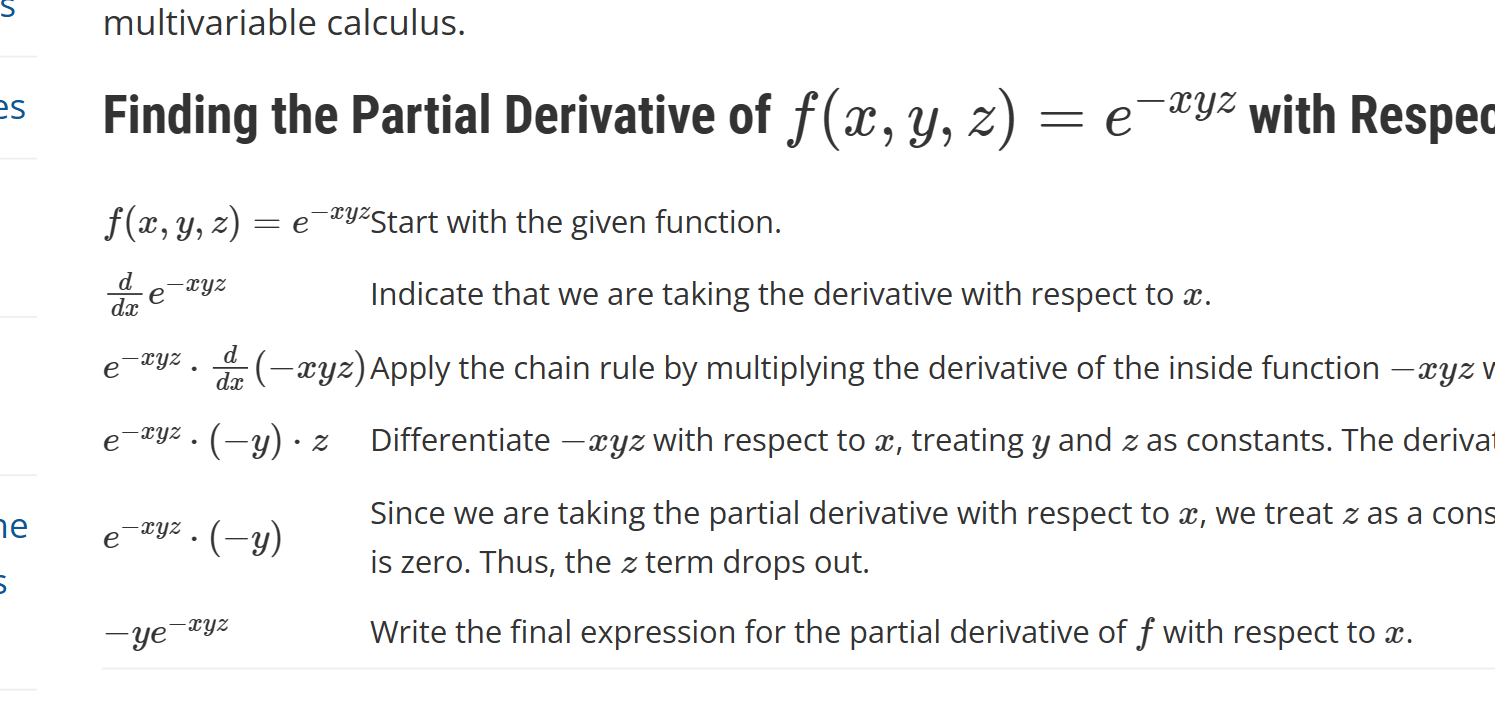Are you looking to understand the intricacies of finding partial derivatives of exponential functions with negative exponents? In this comprehensive guide, we break down the process of differentiating the function e^(-xyz) with respect to each variable x, y, and z. Through detailed step-by-step examples, we explore how to apply the chain rule and other differentiation techniques to find the partial derivatives of this specific exponential function. Whether you’re a student, educator, or math enthusiast, this guide provides valuable insights to enhance your understanding of multivariable calculus.
Finding the Partial Derivative of \( f(x, y, z) = e^{-xyz} \) with Respect to \( x \): A Detailed Guide
| \( f(x, y, z) = e^{-xyz} \) | Start with the given function. |
| \( \frac{{d}}{{dx}} e^{-xyz} \) | Indicate that we are taking the derivative with respect to \( x \). |
| \( e^{-xyz} \cdot \frac{{d}}{{dx}} (-xyz) \) | Apply the chain rule by multiplying the derivative of the inside function \(-xyz\) with the original function \( e^{-xyz} \). |
| \( e^{-xyz} \cdot (-y) \cdot z \) | Differentiate \(-xyz\) with respect to \( x \), treating \( y \) and \( z \) as constants. The derivative is \(-y \cdot z\). |
| \( e^{-xyz} \cdot (-y) \) | Since we are taking the partial derivative with respect to \( x \), we treat \( z \) as a constant, and the derivative of a constant is zero. Thus, the \( z \) term drops out. |
| \( -ye^{-xyz} \) | Write the final expression for the partial derivative of \( f \) with respect to \( x \). |
This step-by-step guide offers a detailed and clear explanation of finding the partial derivative of the function \( f(x, y, z) = e^{-xyz} \) with respect to \( x \). By focusing on individual steps and providing thorough explanations, we make this complex mathematical concept accessible and easy to understand. Explore more mathematical guides and tutorials on our website to continue building your mathematical expertise!
Finding the Partial Derivative of \( f(x, y, z) = e^{-xyz} \) with Respect to \( y \): A Detailed Guide
Understanding the process of finding partial derivatives is essential in multivariable calculus. In this guide, we focus on finding the partial derivative of the function \( f(x, y, z) = e^{-xyz} \) with respect to \( y \).
| \( \frac{{d}}{{dy}} e^{-xyz} \) | Indicate that we are taking the derivative with respect to \( y \). |
| \( e^{-xyz} \cdot \frac{{d}}{{dy}} (-xyz) \) | Apply the chain rule by multiplying the derivative of the inside function \(-xyz\) with the original function \( e^{-xyz} \). |
| \( e^{-xyz} \cdot (-x) \cdot z \) | Differentiate \(-xyz\) with respect to \( y \), treating \( x \) and \( z \) as constants. The derivative is \(-x \cdot z\). |
| \( e^{-xyz} \cdot (-x) \) | Since we are taking the partial derivative with respect to \( y \), we treat \( z \) as a constant, and the derivative of a constant is zero. Thus, the \( z \) term drops out. |
| \( -xe^{-xyz} \) | Write the final expression for the partial derivative of \( f \) with respect to \( y \). |
This step-by-step guide provides a clear and comprehensive explanation of finding the partial derivative of the function \( f(x, y, z) = e^{-xyz} \) with respect to \( y \). By breaking down the process into individual steps, we make this essential mathematical concept accessible to students, educators, and math enthusiasts. Explore more mathematical guides and tutorials on our website to continue your learning journey!
Finding the Partial Derivative of \( f(x, y, z) = e^{-xyz} \) with Respect to \( z \): A Detailed Guide
Exploring the world of partial derivatives opens doors to advanced mathematical understanding. In this guide, we focus on finding the partial derivative of the function \( f(x, y, z) = e^{-xyz} \) with respect to \( z \).
| \( \frac{{d}}{{dz}} e^{-xyz} \) | Indicate that we are taking the derivative with respect to \( z \). |
| \( e^{-xyz} \cdot \frac{{d}}{{dz}} (-xyz) \) | Apply the chain rule by multiplying the derivative of the inside function \(-xyz\) with the original function \( e^{-xyz} \). |
| \( e^{-xyz} \cdot (-x) \cdot y \) | Differentiate \(-xyz\) with respect to \( z \), treating \( x \) and \( y \) as constants. The derivative is \(-x \cdot y\). |
| \( e^{-xyz} \cdot (-xy) \) | Since we are taking the partial derivative with respect to \( z \), we treat \( x \) and \( y \) as constants, and the derivative of a constant is zero. Thus, the \( x \) and \( y \) terms remain. |
| \( -xye^{-xyz} \) | Write the final expression for the partial derivative of \( f \) with respect to \( z \). |
This step-by-step guide offers a detailed and clear explanation of finding the partial derivative of the function \( f(x, y, z) = e^{-xyz} \) with respect to \( z \). By focusing on individual steps and providing thorough explanations, we make this complex mathematical concept


